Perennial. Culms tufted, 50–120 cm tall, 0.5–2 mm in diam., not or little branched, nodes bearded. Leaf sheaths glabrous or pilose, ciliate at mouth; leaf blades 15–30 × 0.3–0.8 cm, scaberulous or pubescent, usually hispid with tubercle-based hairs toward base, base rounded, apex acuminate; ligule 0.5–1 mm. Panicle oblong in outline, 9–20 × 2–5 cm; branches untidily flexuous, pilose in axils; racemes usually composed of triads, occasionally with 1–2 additional spikelet pairs, purple; rachis internodes and pedicels shortly ciliate at base. Sessile spikelet 3–4 mm; lower glume oblong-lanceolate, slightly glossy, back 2-veined, shallowly concave between veins, hispidulous, margins keeled, pectinate-ciliate above middle, apex narrowly obtuse; upper glume ciliate along upper margins; awn of upper lemma 1–1.5 cm. Pedicelled spikelet equaling the sessile and often staminate, or smaller and barren. Fl. and fr. Aug–Dec. 2n = 20, 40, 60.
Caespitose perennial; culms mostly 75–100 cm high with barbate nodes; leaf sheaths tight or eventually slipping from the culms, the lowermost longer than and the remainder shorter than the internodes, ± covered in tubercle-based hairs and frequently villous on the collar; ligule a very short, truncate, ciliolate membrane; leaf laminas up to 30 cm × 2.5 mm, glaucous, erect and straight, linear from an often narrowed and slightly contracted base, flat, scabrid on the margins, finely pointed at the apex.
Sessile spikelet 2.8–5 mm long, narrowly oblong; inferior glume with short hairs on the back, shallowly concave in the middle, with 2 intercarinal nerves, ciliate on the keels above, truncate at the apex; superior glume 1-keeled, scabrid on the keel, the median nerve excurrent as a short mucro; inferior lemma empty, 2–2.5 mm long, ovate; superior lemma stipitiform, linear, flattened, 1-nerved, entire; awn c. 20 mm long (including the lemma), minutely hispidulous; anthers c. 1.5 mm long.
Tufted perennial; culms slender, 50–150 cm. high.. Leaf-blades 10–30 cm. long, 2–7 mm. wide.. Inflorescence 8–25 cm. long; racemes reduced to a single triad of 1 sessile and 2 pedicelled spikelets, rarely with 2 sessile spikelets.. Sessile spikelet narrowly oblong, 3–4 mm. long, scabrid, occasionally pubescent, acute; lower glume shallow concave, with 2 intercarinal nerves; awn 10–15 mm. long.. Pedicelled spikelet lanceolate, 2.5–3.5 mm. long.
Pedicelled spikelets 2.5–3.5 mm long, lanceolate, male or neuter; inferior glume shortly hairy on the keels, with 3 intercarinal nerves, acute at the apex; superior glume glabrous, with 2 intercarinal nerves; inferior lemma oblong, truncate; anthers c. 1.5 mm long.
Panicle 8–25 cm long; racemes reduced to 1 sessile and 2 pedicelled spikelets, rarely with 2 sessile and 3 pedicelled spikelets; rhachis internodes glabrous, the pedicels hairy on the margins.

